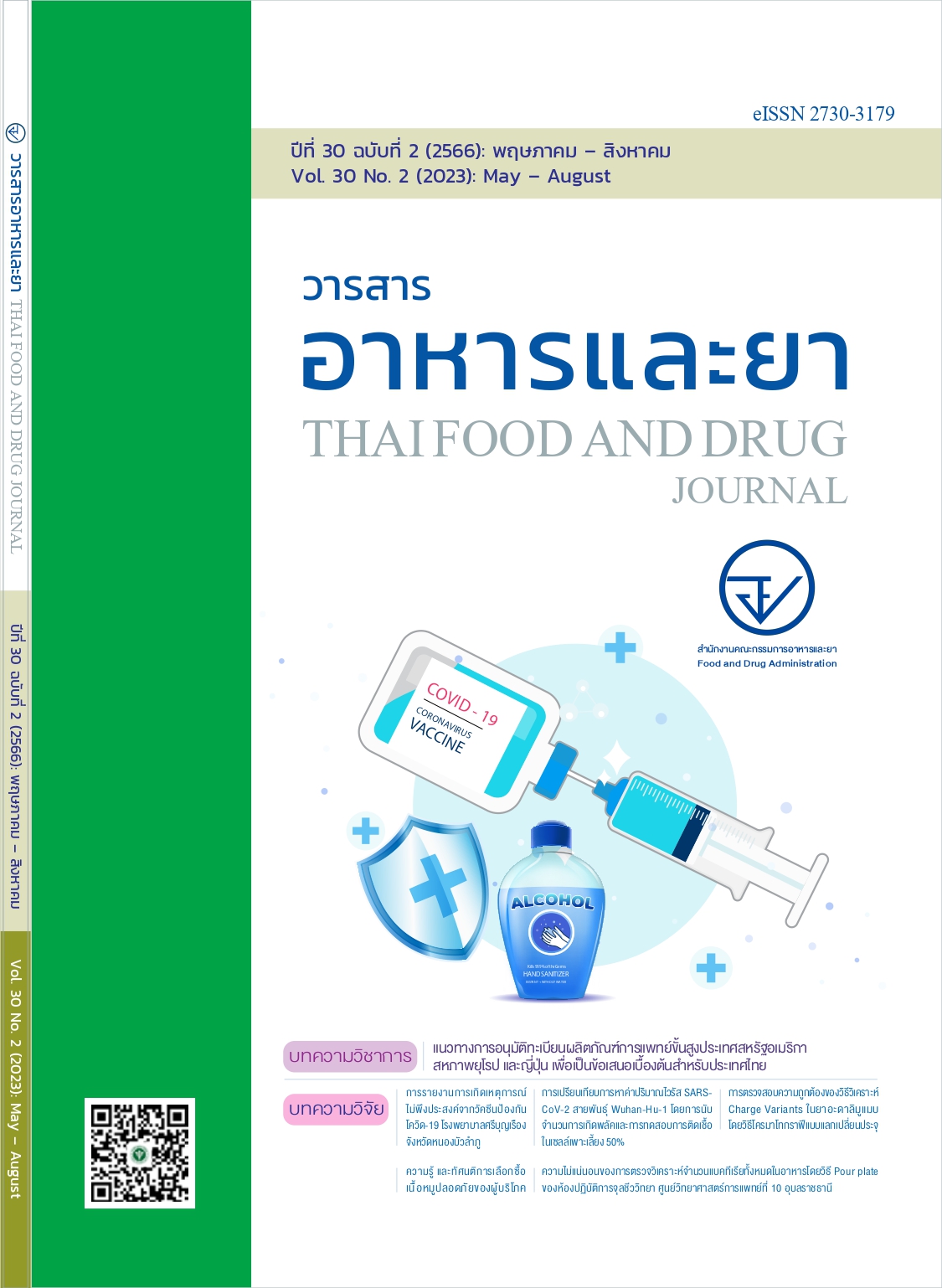ความไม่แน่นอนของการตรวจวิเคราะห์จำนวนแบคทีเรียทั้งหมดในอาหารโดยวิธี Pour plate ของห้องปฏิบัติการจุลชีววิทยา ศูนย์วิทยาศาสตร์การแพทย์ที่ 10 อุบลราชธานี
Main Article Content
บทคัดย่อ
ความสำคัญ: จำนวนแบคทีเรียทั้งหมดเป็นเชื้อจุลินทรีย์ที่ใช้เป็นดัชนีบ่งชี้การเน่าเสียของอาหาร หากปริมาณเชื้อมีจำนวนมากอาจส่งผลให้เกิดความเจ็บป่วยได้โดยเฉพาะในเด็กที่มีภูมิคุ้มกันต่ำ เช่น อาการปวดท้อง คลื่นไส้ อาเจียน และมีไข้ กระทรวงสาธารณสุขจึงกำหนดเกณฑ์มาตรฐานไว้ในอาหารหลายประเภท ห้องปฏิบัติการจุลชีววิทยา ศูนย์วิทยาศาสตร์การแพทย์ที่ 10 อุบลราชธานี เป็นหน่วยงานที่ได้รับการรับรองมาตรฐาน ISO/IEC 17025: 2017 ตรวจวิเคราะห์จำนวนแบคทีเรียทั้งหมดในอาหารโดยใช้วิธีมาตรฐานสากล BAM (online) Chapter 3. 2001 ด้วยเทคนิค Pour plate และได้หาค่าความไม่แน่นอนของการตรวจวิเคราะห์เพื่อแสดงถึงความสามารถของห้องปฏิบัติการตามมาตรฐาน ISO 19036: 2009 ซึ่งมาตรฐานฉบับนี้กำหนดค่าความไม่แน่นอนจากผลลัพธ์ของความเบี่ยงเบนมาตรฐานของการทำซ้ำได้เท่านั้น แต่เนื่องจากมาตรฐาน ISO 19036: 2019 ฉบับใหม่กำหนดให้เทคนิค pour plate ต้องคำนวณค่าความไม่แน่นอนจาก 3 องค์ประกอบคือ Techical uncertainty, Matrix uncertatnty และ Distribution uncertainty มาคำนวณค่าความไม่แน่นอนขยาย ด้วยเหตุนี้ศูนย์ ฯ จึงต้องศึกษาหาค่าความไม่แน่นอนเพื่อให้สอดคล้องกับมาตรฐานฉบับปัจจุบัน
วัตถุประสงค์: เพื่อหาผลลัพธ์ของการเบี่ยงเบนมาตรฐานของการทำซ้ำได้ภายในห้องปฏิบัติการ (SIR) และนำมาใช้ในการคำนวณค่าความไม่แน่นอนขยายของการรายงานผลการตรวจวิเคราะห์
วิธีการวิจัย: เป็นการวิจัยเชิงทดลองในห้องปฏิบัติการศูนย์วิทยาศาสตร์การแพทย์ที่ 10 อุบลราชธานีระหว่างเดือนสิงหาคม-ตุลาคม 2563 มีผู้วิเคราะห์จำนวน 4 คน ตรวจวิเคราะห์จำนวนแบคทีเรียทั้งหมดในตัวอย่างอาหารชนิดเดียวกันที่ตรวจเป็นงานประจำของห้องปฏิบัติการตามวิธีมาตรฐาน BAM Online (2001) Chapter 3 จำนวน 10 ตัวอย่าง ได้แก่ เส้นกวยจั๊บ นม น้ำปลาร้า ซอส ผงปรุงรส ไอศกรีม ไส้หรอก แหนม ซูชิ และตัวอย่างทดสอบชนิด lyophillze นำผลการตรวจวิเคราะห์ของทุกคนมาหาค่า SIR หรือ Technical Uncertainty (utech) คำนวณค่าความไม่แน่นอนจากผลรวมของ utech , Matrix Uncertainty (umatrix) และ Distributional Uncertainty (upoisson) เพื่อคำนวณค่าความไม่แน่นอนขยายสำหรับใช้รายงานผลการทดสอบ
ผลการศึกษา: ผลการตรวจวิเคราะห์จำนวนแบคทีเรียในตัวอย่างอาหารจำนวน 10 ตัวอย่างที่ของผู้วิเคราะห์จำนวน 4 คน พบว่าจำนวนแบคทีเรียทั้งหมดของการตรวจวิเคราะห์แต่ละตัวอย่างให้ผลใกล้เคียงกันทุกตัวอย่างเมื่อเปรียบเทียบค่าเฉลี่ยของผลการตรวจวิเคราะห์ของผู้วิเคราะห์พบว่าไม่แตกต่างกันอย่างมีนัยสำคัญทางสถิติ (p-value = 0.9989) ผลการคำนวณค่าการเบี่ยงเบนมาตรฐานของการทำซ้ำได้ภายในห้องปฏิบัติการ (SIR) = 0.0946 ซึ่งนำมาใช้ในการคำนวณค่าความไม่แน่นอนขยายสำหรับรายงานในใบรายงานผลการตรวจวิเคราะห์จำนวนแบคทีเรียทั้งหมดในอาหารเพื่อแสดงขอบเขตความคลาดเคลื่อนของผลการตรวจวิเคราะห์ที่ระดับความเชื่อมั่นร้อยละ 95
สรุป: ค่าการเบี่ยงเบนมาตรฐานของการทำซ้ำได้ภายในห้องปฏิบัติการ (SIR) มีความเหมาะสมในการนำมาใช้หาค่าความไม่แน่นอนของการตรวจวิเคราะห์จำนวนแบคทีเรียทั้งหมดในอาหาร แต่ห้องปฏิบัติการควรมีการทดสอบชนิดตัวอย่างอาหารเพิ่มเติมเพื่อตรวจสอบหรือเฝ้าระวังค่า SIR ไม่ให้สูงเกินเกณฑ์ที่ห้องปฏิบัติการกำหนดไว้คือไม่เกิน 0.1 หากมีค่าเกินเกณฑ์ห้องปฏิบัติการต้องวิเคราะห์ปัจจัยที่มีผลต่อการทดสอบ และทำการปรับปรุงแก้ไข กรณีที่มีการเปลี่ยนผู้วิเคราะห์ในห้องปฏิบัติการต้องมีการหาค่า SIR ใหม่ให้ทันสมัย
Article Details

อนุญาตภายใต้เงื่อนไข Creative Commons Attribution 4.0 International License.
เอกสารอ้างอิง
ศูนย์เครือข่ายข้อมูลอาหาร. การเสื่อมเสียของอาหารเนื่องจากจุลินทรีย์ [อินเทอร์เน็ต]. 2563 [เข้าถึงเมื่อ 15 พ.ย. 2565]. เข้าถึงได้จาก: https://www.foodnetworksolution.com/wiki/word/1856/การเสื่อมเสียของอาหารเนื่องจากจุลินทรีย์-microbial-spoilage
กระทรวงสาธารณสุข. ประกาศกระทรวงสาธารณสุข (ฉบับที่ 350) พ.ศ. 2556 เรื่อง นมโค. ราชกิจจานุเบกษา ฉบับประกาศทั่วไปเล่มที่ 130, ตอนพิเศษ 87 ง (ลงวันที่ 24 กรกฎาคม 2556).
กระทรวงสาธารณสุข. ประกาศกระทรวงสาธารณสุข (ฉบับที่ 210) พ.ศ. 2543 เรื่อง อาหารกึ่งสำเร็จรูป. ราชกิจจานุเบกษา ฉบับประกาศทั่วไปเล่มที่ 118, ตอนพิเศษ 6 ง (ลงวันที่ 24 มกราคม 2544).
ISO/ IEC 17025: 2017 General Requirement for the Competence of Testing and Calibration Laboratories. 2017(E); 2017.
U.S. Food and Drug. Bacteriological Analytical Manual. Chapter 3. Aerobic plate count; 2017 [cited 2017 Jan 14]. Available from: https://www.fda.gov/food/laboratory-methods-food/bam-chapter-3-aerobic-plate-count
รวิวรรณ อาจสำอาง. ความแตกต่างของการหาความไม่แน่นอน ของการทดสอบทางเคมีและจุลชีววิทยา.วารสารสำนักบริหารและรับรองห้องปฏิบัติการ (บร.) 2552;6(16-17):5-7.
ISO/IEC GUIDE 98-3:2008 Uncertainty of measurement Part 3: Guide to the expression of uncertainty in measurement (GUM:1995); 2008 [cited 2022 Jul 3]. Available from:
ISO 19036: 2019 (E). Microbiological of Food and Animal Feeding Stuffs - Guidelines for the Estimation of Measurement Uncertainty for Quantitative Determinations; 2019
ISO 7218:2007/AMD.1:2013(E). Microbiological of food and animal feeding Stuffs – General Requirements and guidance for microbiological examinations [Internet].2020 [cited 2020 Aug 31]. Available from: https://masm.gov.mn/masmj/wp-content/uploads/2019/09/ISO_7218_2007_Amd_1_201328E29-Character_PDF_document.pdf
กรมวิทยาศาสตร์การแพทย์. แนวทางการใช้กฎการตัดสินผลการทดสอบ/สอบเทียบและการรายงานความสอดคล้องกับเกณฑ์ของผลิตภัณฑ์; 2564.
พรทิพย์ ศรีศร, มุทิตา คณฑา, จำรัส พูลเกื้อ. การศึกษาเพื่อพัฒนาความสามารถของห้องปฏิบัติการสำหรับการประมาณค่าความไม่แน่นอนของการนับปริมาณจุลินทรีย์ทั้งหมดในตัวอย่างผลิตภัณฑ์น้ำพริกพร้อมบริโภค และขนม. วารสารอาหารและยา 2557;21(1):49-58.
Yunxia, W. and et al. Evaluation of Uncertainty of Detection Results of Aerobic Plate Count. Asian Agricultural Research [Internet]. 2021 [cited 2022 Jul 3]; 13(6): 59-63. Available from: https://ageconsearch.umn.edu/record/316960
กิจติศักดิ์ ยศอินทร์. การศึกษาผลกระทบของเนื้อสารตัวอย่างและประเภทของแบคทีเรียที่มีผลต่อค่าความไม่แน่นอนของการทดสอบทางจุลชีววิทยา. วารสารวิทยาศาสตร์ประยุกต์ กรมวิทยาศาสตร์บริการ 2556;2(2):77-83.


